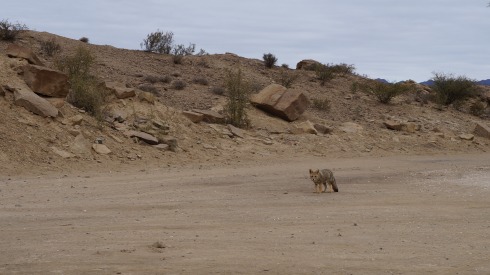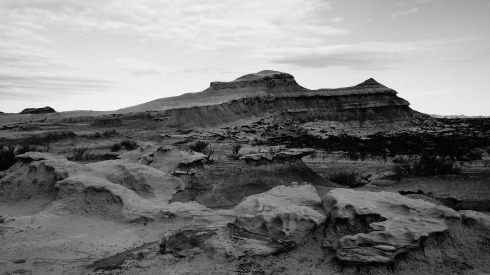Parque Provincial Ischigualasto is located in the San Juan province of Argentina and was declared a provincial park in 1971 due to its paleontological significance and stunning landscapes. The park was relatively unheard of until a series of events made it one of the regions most popular tourists sites. William Sill, a leading paleontologist and researcher helped to put Ischigualasto on the map by documenting the Park’s abundance of Triassic Period fossils and dinosaur bones, some up to 180 million years old. Then, a photographer published a series of stunning pictures capturing the park’s fantastical landscapes and he cleverly entitled the portfolio ‘Valley of the Moon’ which captured many people’s imaginations. To seal the deal UNESCO declared the area a ‘Natural Heritage of Humanity’ site in November 2000 and visitors started to arrive in their hordes.
We travelled 4 hours by local bus from the city of San Juan to the tiny village of Valle Fertil and from there we arranged a tour to the park. Due to the park’s isolation and sheer size, once inside the park, a mini bus drove us around a 40km path and stopped at five points of interest enabling us to walk around contrasting landscapes and surreal rock formations.
Number 1 – El Gusano
A ranger joined us in the mini van and we drove roughly 20 minutes along a bumpy, unpaved road before reaching the first site. We were instantly struck by the sheer size of the sculpture and we listened intently to learn how formations like this one had come to be in the park.
The scenery enhanced the already unusual feel to the landscape with bright white sand, shrubs with small coloured flowers and large cacti. The ranger explained that the unusual formations in the park were formed by wind and rain erosion of the sedimentary rock over millions of years.
We walked around the rock and moved up close to take a better look. The rock was rough with hundreds of layers of sediment made up of different minerals, colours and we were also shown fossilised animals embedded in the rock.
As we were returning to the mini van a Patagonian fox made an appearance and seemed almost as interested in us and we were in him.
Number 2 – Valle Pintado
We drove further into the park and stopped at a viewing point overlooking dramatic multi-coloured canyons which had been formed by compressed volcanic ash. Fluffy clouds blanketed the sky at this point adding to the eery feel of the landscape and without the bright sun, the colours in the rock glowed even more vibrantly.
The undulating rock formations were really smooth and with an old hessian sack they’d make an excellent slide like the ones you’d find at the end of an old-fashioned seaside pier.
The ranger explained that just a few hundred metres away from where we stood, one of the oldest dinosaur fossils ever to be found, was discovered.
Number 3 – Concha de Bochas
The landscape became more unusual the further into the park we drove. The ranger explaned that the name Ischigualasto means ‘place where the moon alights’ in Quechua language and it certainly felt like we weren’t on Earth any more.
We stopped at a clearing and walked roughly 10 minutes through a landscape of natural stone sculptures.
The ranger picked out random rocks and had a nick-name for all of them – some we could guess straight away and for others we needed to squint our eyes and use a bit of imagination. One of the most astonishing likenesses to the real thing was a rock called The Sphinx – we really could have been in Ancient Egypt or perhaps Trafalgar Square in central London.
We arrived at the top of a small incline and received our first view of the Bochas (literally translated as ‘balls’) – about 100 of them, all perfectly round and between 10 – 50 centimetres in diameter, were haphazardly arranged on the ground.
The ranger explained that there used to be hundreds more Bochas all arranged in a semi-circle but over several years the stocks were depleted as visitors to the park took them home as souvenirs. The park has now taken steps to protect its wonders and guides are vigilant not to let visitors venture past a 5 metre exclusion zone marked on the ground with a circle of rocks.
The ranger explained that millions of years ago the whole park was a huge lake and the area where the Bochas can now be found was the lowest point of the deep lake bed. Over millions of years sediment dropped to the bottom of the lake, rolled down the steep underwater banks and compacted tightly into ball shapes. As we admired the Bochas the ranger said that some people are disappointed when they arrive at the site as they’ve seen pictures taken with a zoom lens which distorts the perspective and they expect them to be giant size when in fact they’re about the size of cannon balls.
As a gentle wind blew and moved sand around we could see the tops of more Bochas gradually being exposed and we thought that perhaps one day the park will have its semi-circle of magical balls back once more.
Number 4 – El Submarino
Sometimes it’s hard to comprehend that nature can create the wonderful spectacles it does and from the moment our bus pulled up at El Submarino we were captivated by the landscape.
In the distance the impressive canyon walls of Barrancas Colorades glowed bright red in the sunshine.
In the foreground the park’s desert landscape stretched out in every direction studded with rocks stacked on top of one another like a game of Jenga played in giant proportions and flecked with patches of green shrubbery that had managed to tap into an underground water source in this dry and barren place.
A light wind whipped up mini cyclones across the plain and sent the clouds chasing through the now blue skies. ‘The Submarine’ surfaced into view as we steadily walked up an incline.
This rock formation wouldn’t have looked out-of-place floating on the open seas with its periscope raised scanning the surroundings ready to defend itself at a moments notice.
We joked with other people on the tour about turning the next bend in the road and coming face to face with a dinosaur hungry for tourists. Perhaps we’d watched too many movies but this park had certainly got our imaginations running wild!
Number 5 – El Hongo
We learnt from the ranger that the word ‘el hongo’ translates as ‘the mushroom’.
It was easy to see why the final sculpture had this name but it still made us laugh. Our mini bus had raced to reach this point before the setting sun disappeared and the good light was lost. As we stood looking up at El Hongobathed in golden sunlight we suddenly felt very tiny.
The rocks making up the structure were perfectly balanced but we felt a destructive urge to walk right up to it and try to push it over like naughty children stomping on mushrooms in a garden. But of course we didn’t!!
As the light was slowly fading our driver beckoned us back towards the bus, It was time to leave this unusual place and head for the exit before nightfall. Our bus scuttled along a small stoney track next to the red canyons. Up close the canyons no longer looked stong and impenetrable but instead they looked like dried out and crumbly plasticine models. The rocks were covered in deep grooves where the occasional torrential downpour had sent rivers of water washing down the canyon’s face. We had a view over the whole park as the dipping sun started to turn the sky vibrant pink and cast long shadows that played tricks with our eyes.
The bright moon had just become visible in the sky and we remarked how surreal it was to be looking up at such a distant and unfamiliar place but feeling like we could now imagine its surface just a little bit better after visiting Ischigualasto. There are those who would argue that the desert is a desolate, lifeless and foreboding place but after just several hours in this park we are convinced that the desert can also be a thing of beauty.


























Wow, should of gone there!, great work guys keep it up!